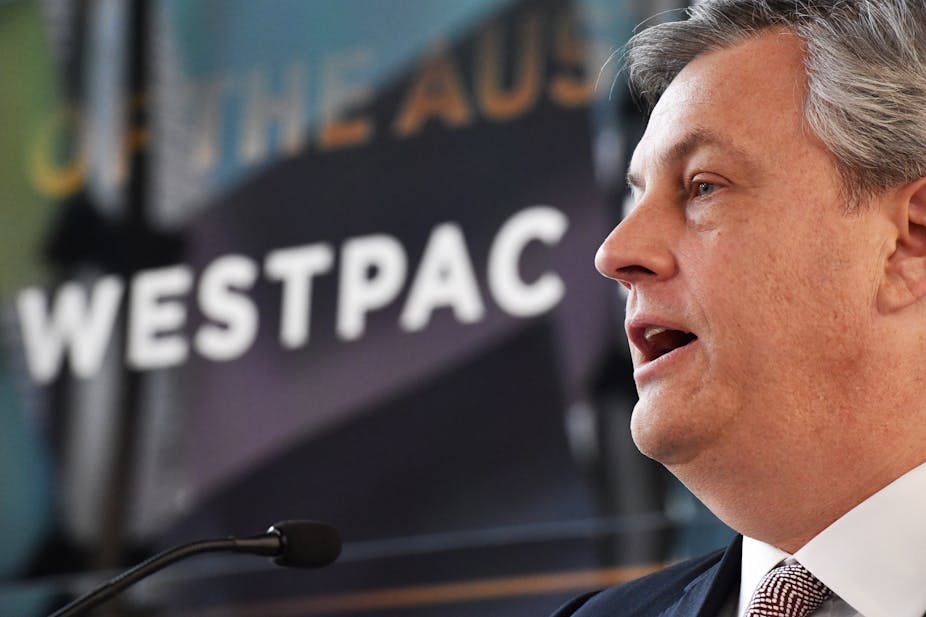Australian banking giant Westpac proudly announced a milestone in its gender equality strategy this week, with half of its 6,000 management positions now filled by women. This marks the realisation of a target set in 2014 by then CEO Gail Kelly.
Current CEO Brian Hartzer was effusive, claiming this was a historic moment not just for Westpac, but for Australia. This is a “signpost that our nation is making progress […] for unlocking the potential of women”, he proclaimed.
Gender gerrymandering?
Questions have been raised over whether the 50% women leaders is a bona fide achievement or a PR stunt. Although Westpac is publicly touting its gender parity, its reports to the Commonwealth’s Workplace Gender Equality Agency state that female gender representation in management has been steady (between 36.6 and 38.6%) since 2012.
In the most recent report, that number falls below 30% if only executives and above are included. Let’s be clear, while these statistics confirm entrenched inequality, they are actually at best-practice levels, and reflect the bank’s concerted efforts in diversity management.
But still, the bank’s public posturing belies how much more work really needs to be done before gender equality at work becomes ingrained in Australian business values on its own terms.
Westpac’s claim of 50% is calculated using an in-house approach which, according to one report, has significantly overstated the improvements. This would mean that Westpac’s equality target was not achieved by having more women in senior positions, but by re-classifying the positions it identified as “management”.
The business case for equality
According to the Diversity Dividend Report produced by Deloitte for Westpac, pursuing gender equity in leadership is worthwhile because there is an incontrovertible “association between gender diversity in senior leaderships and firm financial performance in Australia”.
Westpac claim that increasing women in leadership roles to parity with men can boost corporate profitability by more than 2 percentage points “on the back of improved teamwork, culture and engagement with stakeholders”.
This type of unashamedly self-interested business case argument has come under significant scrutiny by diversity researchers for decades. Research shows that the rationale that businesses use to justify diversity programs is almost always based on the business benefits it will deliver.
The danger this brings is that a politics of change and a feminist social justice agenda is stripped out of equality and replaced with corporate friendly strategic plans and key performance indicator (KPI) reports.
This is not without controversy. Researchers have questioned whether equality should be pursued for the commercial returns that it promises, for the benefit of particular women, or because it is a central part of social justice.
Diversity and corporate ‘greatness’
When the business case is used it has even been shown that nominally ethical practices like gender diversity can be less about a genuine concern with justice, and more about a manipulative and narcissistic urge to look good.
In our own work we have surmised that the publicity surrounding corporate ethical initiatives often reduces them to being little more than the pursuit of an aura of corporate greatness – itself belonging to a long standing masculine tradition of competitive self-aggrandisement.
This may well be the case at Westpac, given that reaching the 50-50 target coincided with an extensive marketing campaign including sponsored news stories and funding a free exhibition at the Sydney Opera House entitled “200 Women: The Listening Ground”.
While this might achieve the goal of sharing the stories of real women, it also places Westpac at the centre of gender equality debates in Australia, enabling it to further leverage diversity for commercial purposes.
Competing for diversity
When Westpac promotes its diversity credentials it does so in competitive terms, saying how much better it is than its business rivals. Here ethical and political demands for equality are reduced to yet another form of market competition.
This kind of rational and self-interested competitive behaviour is no way to make real changes to the masculine cultures and structures that drive corporations – characteristics of the very workplace environments that so many women turn their backs on.
To reach equality on women’s terms rather than its own, Westpac should foster institutional practices that support the diversity of women, rather than competitive diversity.
Equality is a political imperative, not a corporate one. While organisations like Westpac have in many ways led the way in putting diversity on the business Australia’s business agenda, we should not forget that equality is a basic right that continues to be denied to women. It is worth fighting for, irrespective of the bottom line and the business case.

